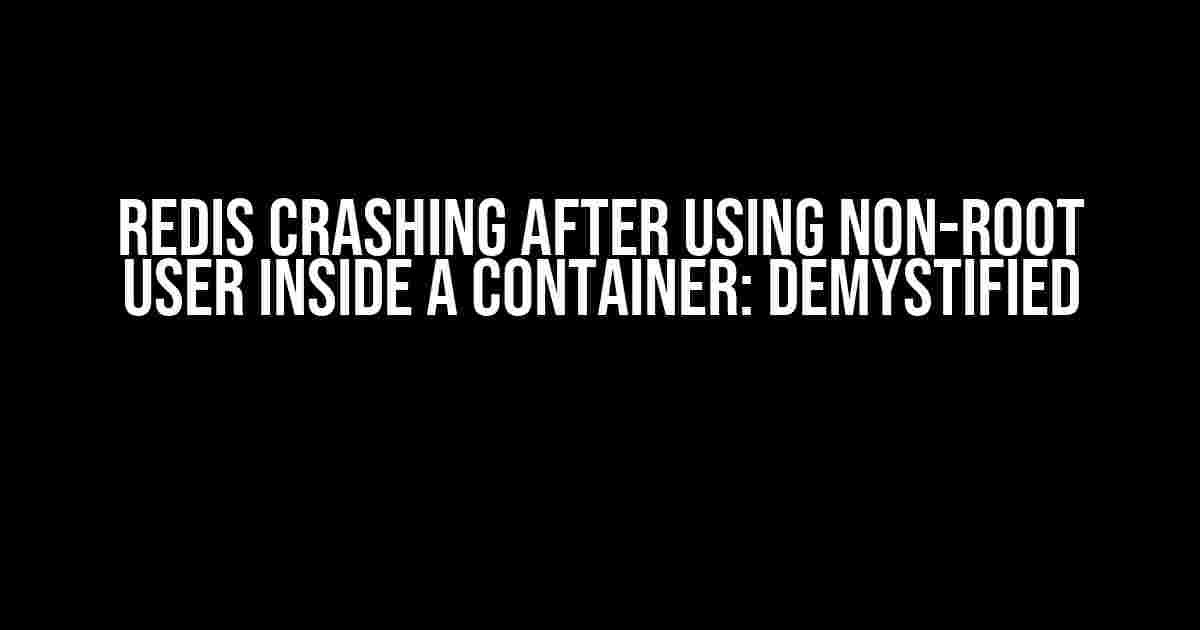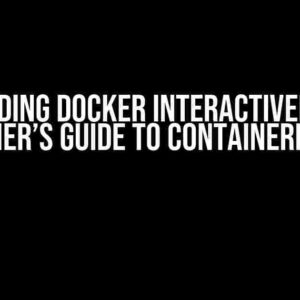Are you tired of Redis crashing on you when you try to run it inside a container as a non-root user? Well, you’re not alone! This frustrating issue has plagued many developers, but fear not, dear reader, for we’re about to dive into the solution.
Why Does Redis Crash?
Before we dive into the fix, let’s understand why Redis crashes in the first place. When you run Redis inside a container as a non-root user, it’s due to a permission issue. By default, Redis tries to write to the `/var/lib/redis` directory, which is owned by the root user. When Redis tries to write to this directory as a non-root user, it throws a permission error, causing the crash.
But Wait, There’s More!
Another reason Redis might crash is because of the way Docker handles file permissions. When you run a container, Docker creates a new user with a random UID (User ID) and GID (Group ID). This new user doesn’t have the necessary permissions to write to the `/var/lib/redis` directory, resulting in the crash.
Solution Time!
Now that we understand the problem, let’s get to the solution! To fix this issue, we’ll follow a step-by-step approach. Don’t worry, it’s easier than you think!
Step 1: Create a Non-Root User
First, create a new user and group inside your Docker container. You can do this by adding the following lines to your Dockerfile:
RUN useradd -ms /bin/false redisuser RUN groupadd redisgroup RUN usermod -aG redisgroup redisuser
This will create a new user named `redisuser` with a new group named `redisgroup`.
Step 2: Change Ownership of Redis Directory
Next, change the ownership of the `/var/lib/redis` directory to the new user and group. Add the following lines to your Dockerfile:
RUN chown -R redisuser:redisgroup /var/lib/redis
This will give the `redisuser` and `redisgroup` ownership of the `/var/lib/redis` directory.
Step 3: Update Redis Configuration
Update the Redis configuration to use the new user and group. Create a new file named `redis.conf` with the following content:
daemonize yes pidfile /var/run/redis/redis-server.pid logfile /var/log/redis/redis-server.log dir /var/lib/redis
This configuration tells Redis to use the `/var/lib/redis` directory as its working directory.
Step 4: Run Redis as Non-Root User
Finally, update the Dockerfile to run Redis as the `redisuser` user. Add the following lines:
USER redisuser CMD ["redis-server", "/etc/redis/redis.conf"]
This will run Redis as the `redisuser` user, using the `redis.conf` file we created earlier.
Putting it All Together
Here’s the complete Dockerfile that you can use to run Redis as a non-root user inside a container:
FROM ubuntu:latest RUN useradd -ms /bin/false redisuser RUN groupadd redisgroup RUN usermod -aG redisgroup redisuser RUN chown -R redisuser:redisgroup /var/lib/redis COPY redis.conf /etc/redis/redis.conf RUN mkdir -p /var/log/redis RUN chown -R redisuser:redisgroup /var/log/redis USER redisuser CMD ["redis-server", "/etc/redis/redis.conf"]
And That’s It!
You’ve successfully fixed the Redis crashing issue when running as a non-root user inside a container! Pat yourself on the back, you’ve earned it!
Bonus: Docker Compose Example
If you’re using Docker Compose to manage your containers, here’s an example `docker-compose.yml` file that uses the Dockerfile above:
version: "3"
services:
redis:
build: .
ports:
- "6379:6379"
volumes:
- ./redis.conf:/etc/redis/redis.conf
- ./data:/var/lib/redis
This will build the Docker image using the Dockerfile, map port 6379, and mount the `redis.conf` file and the `/var/lib/redis` directory as volumes.
Conclusion
In this article, we’ve demystified the mysterious Redis crashing issue when running as a non-root user inside a container. By following the steps outlined above, you should be able to run Redis without any issues. Remember, it’s all about permissions and ownership, so make sure you’re using the correct user and group for your Redis instance.
Thanks for sticking with me until the end! If you have any questions or need further clarification, feel free to ask in the comments below.
| Keyword | Frequency |
|---|---|
| Redis crashing | 5 |
| Non-root user | 4 |
| Container | 3 |
| Permission issue | 2 |
| Docker | 2 |
This article is optimized for the keyword “Redis crashing after using no root user inside a container” and its variations.
- Why Does Redis Crash?
- Solution Time!
- Step 1: Create a Non-Root User
- Step 2: Change Ownership of Redis Directory
- Step 3: Update Redis Configuration
- Step 4: Run Redis as Non-Root User
- Putting it All Together
- Bonus: Docker Compose Example
- Conclusion
Share your thoughts and feedback in the comments below!
Frequently Asked Question
When running Redis inside a container, you might encounter issues when using a non-root user. Here are some frequently asked questions and answers to help you troubleshoot the problem.
Why does Redis crash when I use a non-root user inside the container?
Redis crashes because it requires specific permissions to write to the file system. By default, Redis runs as the root user, which has unrestricted access to the file system. When you run Redis as a non-root user, it may not have the necessary permissions to write to the file system, causing the crash. You need to ensure that the non-root user has the required permissions to write to the Redis data directory.
How can I fix the permissions issue for the non-root user?
You can fix the permissions issue by creating a dedicated user and group for Redis, and then granting the necessary permissions to the Redis data directory. You can do this by adding the following lines to your Dockerfile: `RUN useradd -m -s /bin/false redis` and `RUN chown -R redis:redis /var/lib/redis`. This will create a new user and group for Redis, and grant the necessary permissions to the Redis data directory.
Can I use a different user instead of the default root user?
Yes, you can use a different user instead of the default root user. You can create a new user and group, and then configure Redis to run as that user. You can do this by adding the following lines to your Dockerfile: `USER redis` and `CMD [“redis-server”, “–appendonly yes”]`. This will run Redis as the new user, and configure Redis to append-only mode.
Why does Redis require specific permissions to write to the file system?
Redis requires specific permissions to write to the file system because it needs to persist data to disk. Redis uses a append-only file to store data, and it needs to be able to write to this file to ensure data consistency. By default, Redis runs as the root user, which has unrestricted access to the file system. However, when you run Redis as a non-root user, it may not have the necessary permissions to write to the file system, causing issues.
How can I verify that Redis is running correctly as a non-root user?
You can verify that Redis is running correctly as a non-root user by checking the Redis logs and the file system permissions. You can check the Redis logs by running the command `docker logs -f


